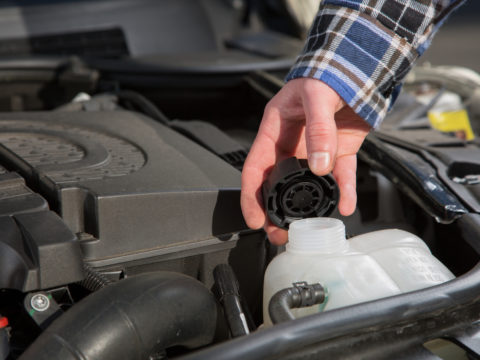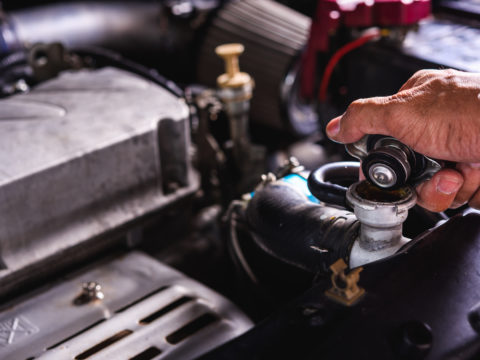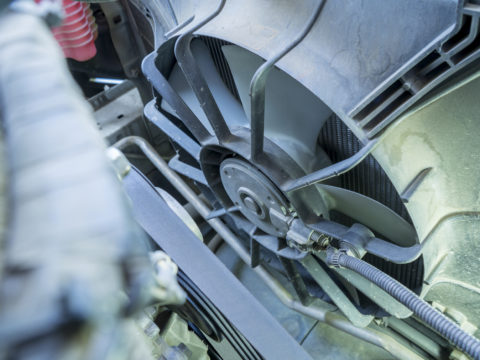If your vehicle’s radiator fan’s not working, your car could be at an increased risk of overheating and engine damage. Plus, a mechanic might charge you an arm and a leg to diagnose and repair the problem. That’s why you should know how to troubleshoot the issue.
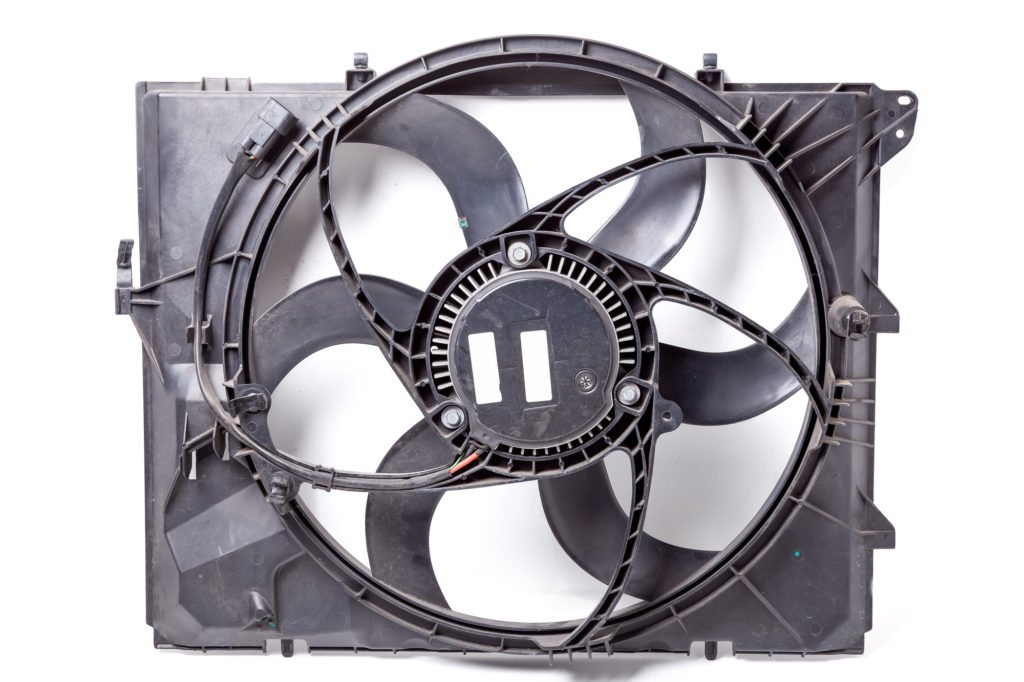
Contents
What Does a Radiator Fan Do?
A radiator fan helps to circulate air through the engine compartment and across the radiator. This extra airflow is important even at speeds when there is a lot of fresh air streaming across the radiator’s fins and cooling the fluid inside.
But when you’ve stopped, and your vehicle starves for fresh and cool air, the radiator fan becomes even more critical. Without a fan circulating the air, the radiator won’t cool the engine enough, and the system may overheat.
Where is the Radiator Fan in a Car?
The radiator fan on a car is usually right in front of the radiator at the very front of the car. Car designs continue to evolve, though. So, on some vehicles, the radiator and fan configuration might be a bit different. There might even be multiple radiators and fans. For instance, the Bugatti Veyron has ten radiators!
But, the most common design has the traditional arrangement of a radiator across the front of the car, with the fan in front of it, so it’s in an ideal place to draw in lots of fresh air.
Radiator Fan Diagram
If you’re curious what a typical layout looks like, check out this diagram of the radiator cooling fans on an early 2000s Jeep Grand Cherokee. There are two fans, both inside of a shroud in front of the boxy radiator.
When Should the Radiator Fan Come On?
A radiator fan should come on when your vehicle needs more cooling than it’s getting. That can be because you’ve stopped with the engine running and there isn’t any air circulating. But there are also driving conditions that might activate the fan.
For instance, if you’re driving very hard or in a very hot climate, the fan may come on to help circulate the air, as the system works to keep the fluid as cool as possible, which in turn keeps the engine from overheating.
How Do You Know the Radiator Fan is Not Working?
The signs of a faulty radiator fan should be pretty obvious. Let’s zero in on some of the most common indicators.
Symptoms of a Faulty Radiator Fan
Some symptoms can be indicative of a radiator’s fan not working.
The Fan Isn’t Turning On
The radiator fan is usually pretty loud when it’s on. So, if your car is hot, and you park it, you should hear the fan. If you don’t, and it seems like a situation where it should be running, you may have a problem.
You’re Running Hot
If your vehicle’s coolant temperature gauge indicates a higher than normal temperature for the operating conditions, the fan might not be turning. The fan should come on by itself when the coolant reaches a predetermined temperature.
So if you think it should be on, and you see the temperature continue to increase, you should shut the car off as soon as possible and investigate further.
Strange Noises
When a fan is starting to fail, it may make some odd noises. So if you hear an odd whirring noise or a clicking sound while the fan is turning, it may indicate that the fan is starting to wear out and may fail quite soon.
Sometimes, the fan might develop an issue even if it doesn’t have an underlying mechanical problem. That’s because the fan, as it’s mounted right at the front of the vehicle, is exposed to debris that kicks up on the road. If one of the blades is damaged, it might affect the fan’s operation and make a clicking noise if something is rubbing.
The Air Conditioner is Weak
The radiator fan often doubles as a fan for the A/C system on a car. So, if the fan isn’t working right, it will negatively affect the performance of that system, and you’ll feel the result when the A/C doesn’t cool off the cabin as it should.
Electrical Issues
Sometimes, a car’s electrical system may develop an issue that prevents the fan from working right. An electrical issue could result in a warning light on the dashboard. Or, you may notice that a fuse has blown. Check your vehicle’s fuse schematic. It should be in the fuse box or your owner’s manual. If it’s a fuse for the radiator fan, you can be pretty confident that your fan is having an issue.
One way to confirm that it’s a problem with a fan that led to the blown fuse is to change the fuse and run the fan again. If it blows right when the fan turns on, the fan is the culprit, and it will need to be replaced.
Common Radiator Fan Problems
Radiator fans have some common signs and symptoms of failure.
Radiator Fan Runs Constantly
If the radiator fan is always on, something is wrong. It should only operate when needed.
The Coolant Temperature Sensor May Have Failed
If the vehicle’s sensor for measuring the coolant’s temperature isn’t working right, it may ask the fan to turn on when it shouldn’t.
Solution
Replace the temperature sensor. It’s often located near the cap on the radiator.
Radiator Fan Wobbling
If you’re hearing ticking or clicking noises as the fan turns, it’s possibly coming into contact with something that it shouldn’t. If you look closely, you may even see that the fan is wobbling on its axis.
The Fan May Be Damaged or Loose
If the fan is wobbling, the fan may have been hit with debris, knocking it out of alignment. Wobbling might also occur if the fan has started working loose from its mounting point.
Inspect the Fan for Damage or a Loose Bolt
You might be able to shine a flashlight on the radiator and inspect it for damage. If there isn’t anything obvious, you could try to remove the shroud and get a closer look. If the fan looks undamaged but wobbles when you spin it by hand, it may need tightening. You may even have to replace the fan if it’s damaged significantly.
The mounting bolt for the fan on the front of a car is often reverse-threaded, so be sure to check a repair book if you are unsure what to do. You may also need a special wrench.
One Radiator Fan Not Working
If your car has two radiator fans, you might notice that only one of them comes on while the other sits idle.
A Blown Fuse or Damaged Wire
If one fan is working and the other isn’t, there may be an interruption to the nonworking fan’s electrical supply.
Check the System
Check your fuse box for any blown fuses. Use the schematic to zero in on the fuses associated with the cooling system. You should also look for damaged wires or even just a loose electrical connection to the fan. You can also check the relays if you have the know-how.
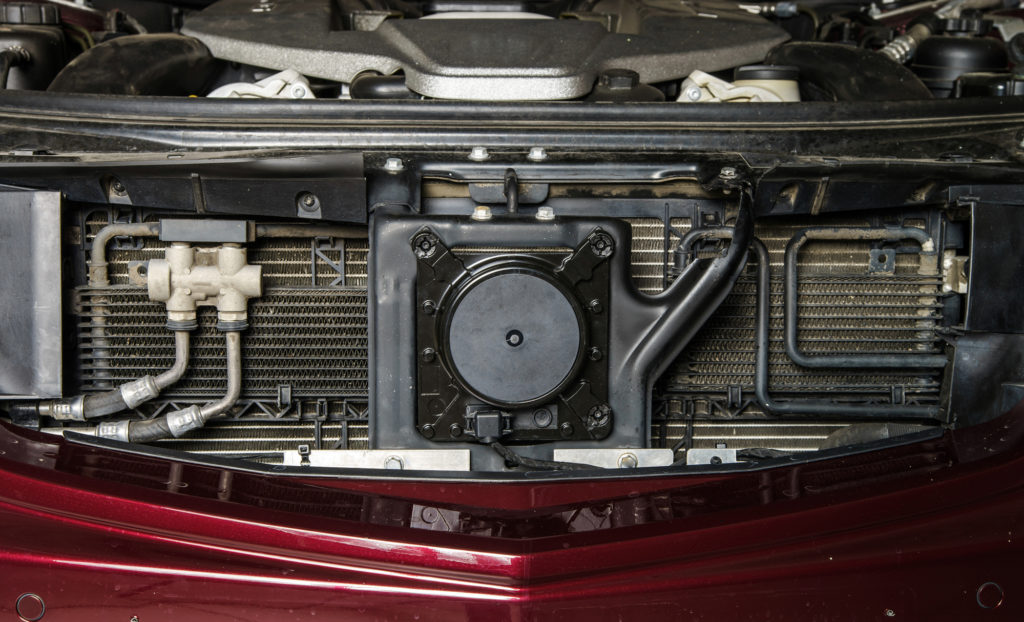
Radiator Fan Not Working When AC is Off
Because the radiator fan is also often part of the A/C system, an issue where the radiator fan won’t work unless the A/C is running is another sign something is wrong.
Burned Out Control Module
Because the cooling system on many vehicles links to the air conditioning system, there is likely a control module that regulates when the fan turns on. Since it probably sits inside the engine bay, it might get wet, dirty, or corroded, causing it to fail or burn out.
Replace the Module
You may be able to see signs of wear on tear on the module. Sometimes, you can even unfasten it and inspect the internal electrical connections for damage. If you think it got wet, you could try drying it out testing the system again. Or, you might have to replace it.
Radiator Fan Turns On and Off Constantly
If the radiator fan starts up and then shuts off repeatedly, it’s not working as it should.
Intermittent Electrical Issues
If the fan is turning off and on repeatedly without reason, it’s pretty likely that there is an issue with the electrical supply going to the fan or one of its regulating components.
Troubleshoot the Electrical System
Troubleshooting the electrical system is a methodical and tedious process. But sometimes, just a close inspection of everything, including the fuses, the relays, the wires, the modules, and the electrical connectors, will reveal something obvious. If you have a multimeter and a repair guide for your vehicle, you can get even deeper into your troubleshooting of the system.
What to Do If the Radiator Fan is Not Working Completely?
If the radiator fan on your car isn’t working right, you should stop driving as soon as possible. Then you can troubleshoot the issue. Coolant can get very hot, especially when the system isn’t working right. So always wear the right safety gear and work carefully in accordance with the manufacturer’s recommendations.
Should You Drive a Car With a Faulty Radiator Fan?
Since the fan is integral to the function of the cooling system, it can be pretty risky to drive with one that’s not working right. A faulty radiator fan could lead to a situation where the radiator isn’t performing up to par, leading to overheated coolant and potentially failure of the radiator or even other systems.
It’s possible that driving with a faulty radiator fan could even lead to major damage to your car’s engine. So, it’s probably not a good idea to keep driving if you think your fan has broken.


